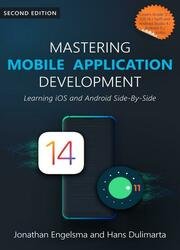 Название: Mastering Mobile Application Development - 2nd Edition : Learning iOS and Android Side-By-Side
Название: Mastering Mobile Application Development - 2nd Edition : Learning iOS and Android Side-By-SideАвтор: Jonathan Engelsma, Hans Dulimarta
Издательство: Leanpub
Год: 2021-01-18
Страниц: 572
Язык: английский
Формат: pdf (true)
Размер: 92.8 MB
Learn to develop native apps on iOS and Android. Leverage what you know about one platform to quickly learn the other, or simply learn both platforms at the same time! This book relates concepts across platforms and is your trusted guide to rapidly mastering mobile app development. This is an updated 2nd Edition of the previous version of the book. We've completely rewritten the book, and refreshed all code examples using the latest versions of Xcode/iOS and Android Studio. In addition, on the Android material, we've replaced the Java language with Kotlin! This book offers developers an in depth tour of these two important platforms. Whether you are just learning to programmer, or you are a seasoned developer, this book will quickly help you grasp the concepts and become proficient.
Our approach is to imagine a fictitious yet non-trivial app that is clearly representative of the many apps consumers currently use daily on their smartphones. Studying how this app is implemented on both iOS and Android in a logical step by step iterative fashion, exploring various facets of the platforms as we go. Each chapter therefore focuses on one a single key aspect of modern mobile apps and begins with a discussion of the concept itself, and a discussion of the commonalities and potential differences in iOS and Android, pertaining to that particular topic. Once the concepts have been fleshed out at a conceptual level, we then introduce concrete examples of how those features are implemented on both iOS and Android.
This comparative approach to learning a software-related topic is not without precedent. For many years accredited university computer science programs have offered courses in programming languages. These courses typically survey a variety of programming language principles, constructs, models, and styles, and illustrate them with concrete examples from a variety of programming languages. A common learning objective is to help the students understand programming language principles that lay beyond the mere syntax, and recognize the concept when it appears again in perhaps an entirely different syntax. Armed with these insights, the student not only learns to write better code in a particular language, but can also rapidly assimilate and learn new languages. For example, a student who has been exposed to lambdas in Ruby and who understand how Ruby implements such constructs, and when they are appropriate to use, will immediately recognize and understand closure expressions when they encounter them for the first time in Swift.
Given the enormous demand for mobile apps and the rapid pace in which iOS and Android are evolving (not mention the platforms that will soon appear on the horizon.) we believe this comparative approach that intentionally calls out concepts in a way that transcends the implementation details will serve the student aspiring to be a professional mobile app developer well. We believe this approach is also germane to the professional developer who is struggling to keep up with the constant avalanche of new mobile implementation frameworks, concepts, and in some cases even entirely new programming languages!
Hence our intended audience consists of both the computer science student, as well as the practicing professional developer. We believe this approach will help the mobile app newbie with no prior knowledge of mobile application development become rapidly proficient on both iOS and Android, and well-prepared to rapidly assimilate whatever our mobile app development futures may hold. We also believe this approach is an excellent way for the experienced developer who is already proficient on either iOS or Android and would like to become proficient on the other. By bridging the knowledge they already have to the other platform, they will quickly orient themselves and become productive.
Скачать Mastering Mobile Application Development - 2nd Edition : Learning iOS and Android Side-By-Side